MANAGEMENT 6: Australia Business Environment Analysis Report
VerifiedAdded on 2022/12/27
|10
|2110
|1
Report
AI Summary
This report provides a comprehensive analysis of the Australian business environment, focusing on the opportunities and threats for international businesses. It begins with an introduction to the complexities of international expansion and the factors influencing the decision to enter a new market. The report then delves into a PEST analysis of Australia, examining the political, economic, sociocultural, and technological factors that impact business operations. The analysis reveals that while the political stability poses a threat, the growing GDP, increasing population, and advanced technological infrastructure present significant opportunities. Furthermore, the report uses Hofstede's cultural dimensions to compare the cultures of Australia and Canada, highlighting similarities and differences in power distance, individualism, masculinity, uncertainty avoidance, long-term orientation, and indulgence. The conclusion summarizes the key findings, emphasizing the importance of considering both the external business environment and cultural nuances when making international business decisions.
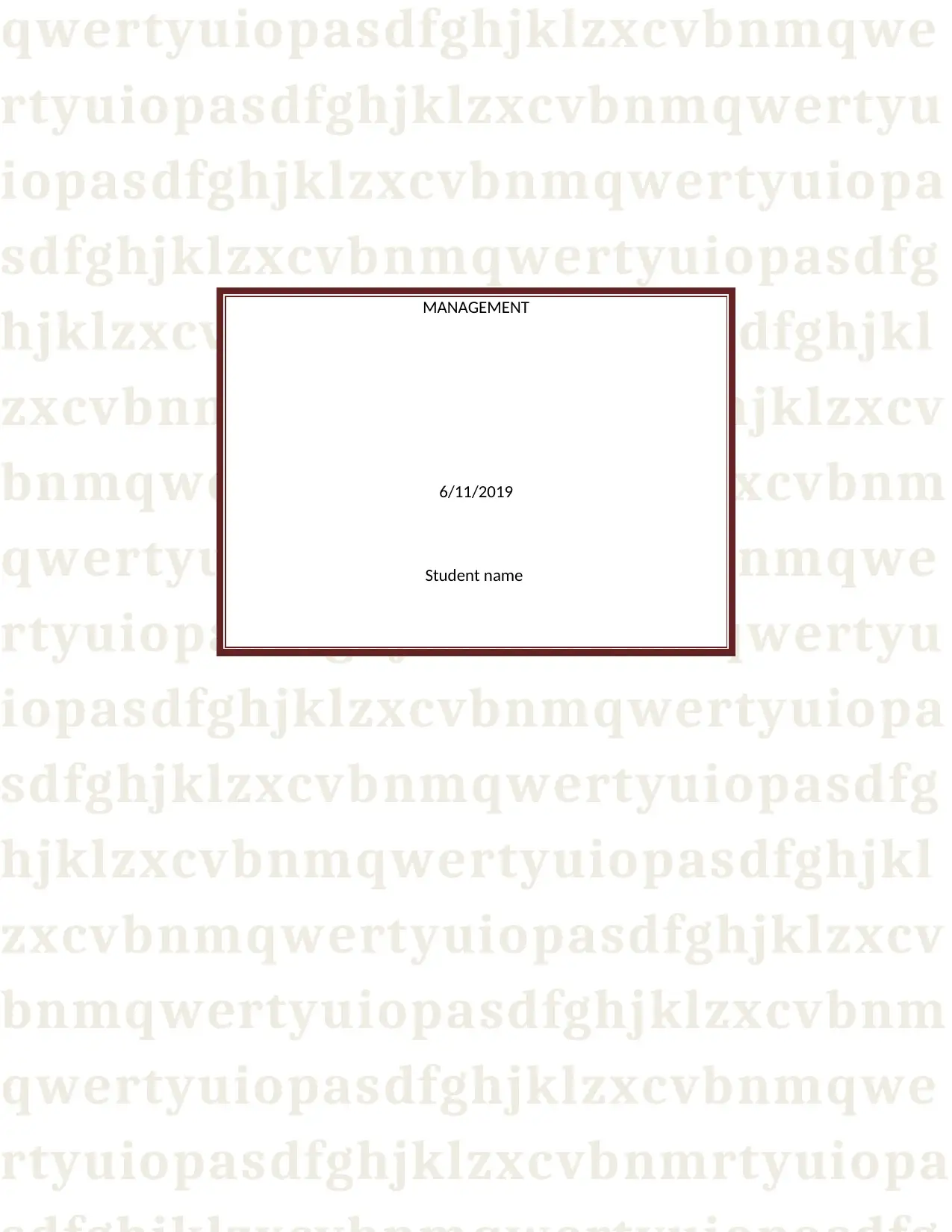
qwertyuiopasdfghjklzxcvbnmqwe
rtyuiopasdfghjklzxcvbnmqwertyu
iopasdfghjklzxcvbnmqwertyuiopa
sdfghjklzxcvbnmqwertyuiopasdfg
hjklzxcvbnmqwertyuiopasdfghjkl
zxcvbnmqwertyuiopasdfghjklzxcv
bnmqwertyuiopasdfghjklzxcvbnm
qwertyuiopasdfghjklzxcvbnmqwe
rtyuiopasdfghjklzxcvbnmqwertyu
iopasdfghjklzxcvbnmqwertyuiopa
sdfghjklzxcvbnmqwertyuiopasdfg
hjklzxcvbnmqwertyuiopasdfghjkl
zxcvbnmqwertyuiopasdfghjklzxcv
bnmqwertyuiopasdfghjklzxcvbnm
qwertyuiopasdfghjklzxcvbnmqwe
rtyuiopasdfghjklzxcvbnmrtyuiopa
MANAGEMENT
6/11/2019
Student name
rtyuiopasdfghjklzxcvbnmqwertyu
iopasdfghjklzxcvbnmqwertyuiopa
sdfghjklzxcvbnmqwertyuiopasdfg
hjklzxcvbnmqwertyuiopasdfghjkl
zxcvbnmqwertyuiopasdfghjklzxcv
bnmqwertyuiopasdfghjklzxcvbnm
qwertyuiopasdfghjklzxcvbnmqwe
rtyuiopasdfghjklzxcvbnmqwertyu
iopasdfghjklzxcvbnmqwertyuiopa
sdfghjklzxcvbnmqwertyuiopasdfg
hjklzxcvbnmqwertyuiopasdfghjkl
zxcvbnmqwertyuiopasdfghjklzxcv
bnmqwertyuiopasdfghjklzxcvbnm
qwertyuiopasdfghjklzxcvbnmqwe
rtyuiopasdfghjklzxcvbnmrtyuiopa
MANAGEMENT
6/11/2019
Student name
Paraphrase This Document
Need a fresh take? Get an instant paraphrase of this document with our AI Paraphraser
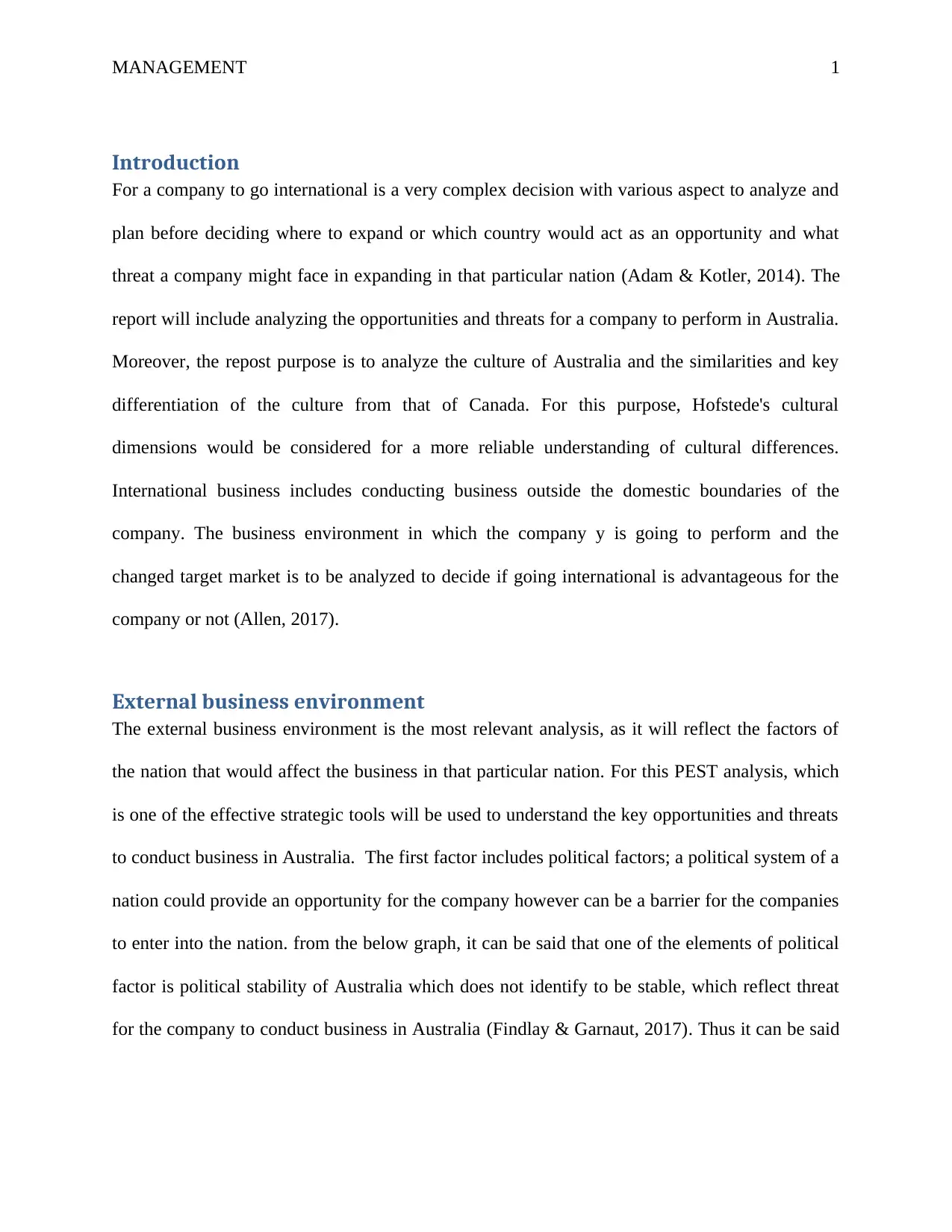
MANAGEMENT 1
Introduction
For a company to go international is a very complex decision with various aspect to analyze and
plan before deciding where to expand or which country would act as an opportunity and what
threat a company might face in expanding in that particular nation (Adam & Kotler, 2014). The
report will include analyzing the opportunities and threats for a company to perform in Australia.
Moreover, the repost purpose is to analyze the culture of Australia and the similarities and key
differentiation of the culture from that of Canada. For this purpose, Hofstede's cultural
dimensions would be considered for a more reliable understanding of cultural differences.
International business includes conducting business outside the domestic boundaries of the
company. The business environment in which the company y is going to perform and the
changed target market is to be analyzed to decide if going international is advantageous for the
company or not (Allen, 2017).
External business environment
The external business environment is the most relevant analysis, as it will reflect the factors of
the nation that would affect the business in that particular nation. For this PEST analysis, which
is one of the effective strategic tools will be used to understand the key opportunities and threats
to conduct business in Australia. The first factor includes political factors; a political system of a
nation could provide an opportunity for the company however can be a barrier for the companies
to enter into the nation. from the below graph, it can be said that one of the elements of political
factor is political stability of Australia which does not identify to be stable, which reflect threat
for the company to conduct business in Australia (Findlay & Garnaut, 2017). Thus it can be said
Introduction
For a company to go international is a very complex decision with various aspect to analyze and
plan before deciding where to expand or which country would act as an opportunity and what
threat a company might face in expanding in that particular nation (Adam & Kotler, 2014). The
report will include analyzing the opportunities and threats for a company to perform in Australia.
Moreover, the repost purpose is to analyze the culture of Australia and the similarities and key
differentiation of the culture from that of Canada. For this purpose, Hofstede's cultural
dimensions would be considered for a more reliable understanding of cultural differences.
International business includes conducting business outside the domestic boundaries of the
company. The business environment in which the company y is going to perform and the
changed target market is to be analyzed to decide if going international is advantageous for the
company or not (Allen, 2017).
External business environment
The external business environment is the most relevant analysis, as it will reflect the factors of
the nation that would affect the business in that particular nation. For this PEST analysis, which
is one of the effective strategic tools will be used to understand the key opportunities and threats
to conduct business in Australia. The first factor includes political factors; a political system of a
nation could provide an opportunity for the company however can be a barrier for the companies
to enter into the nation. from the below graph, it can be said that one of the elements of political
factor is political stability of Australia which does not identify to be stable, which reflect threat
for the company to conduct business in Australia (Findlay & Garnaut, 2017). Thus it can be said
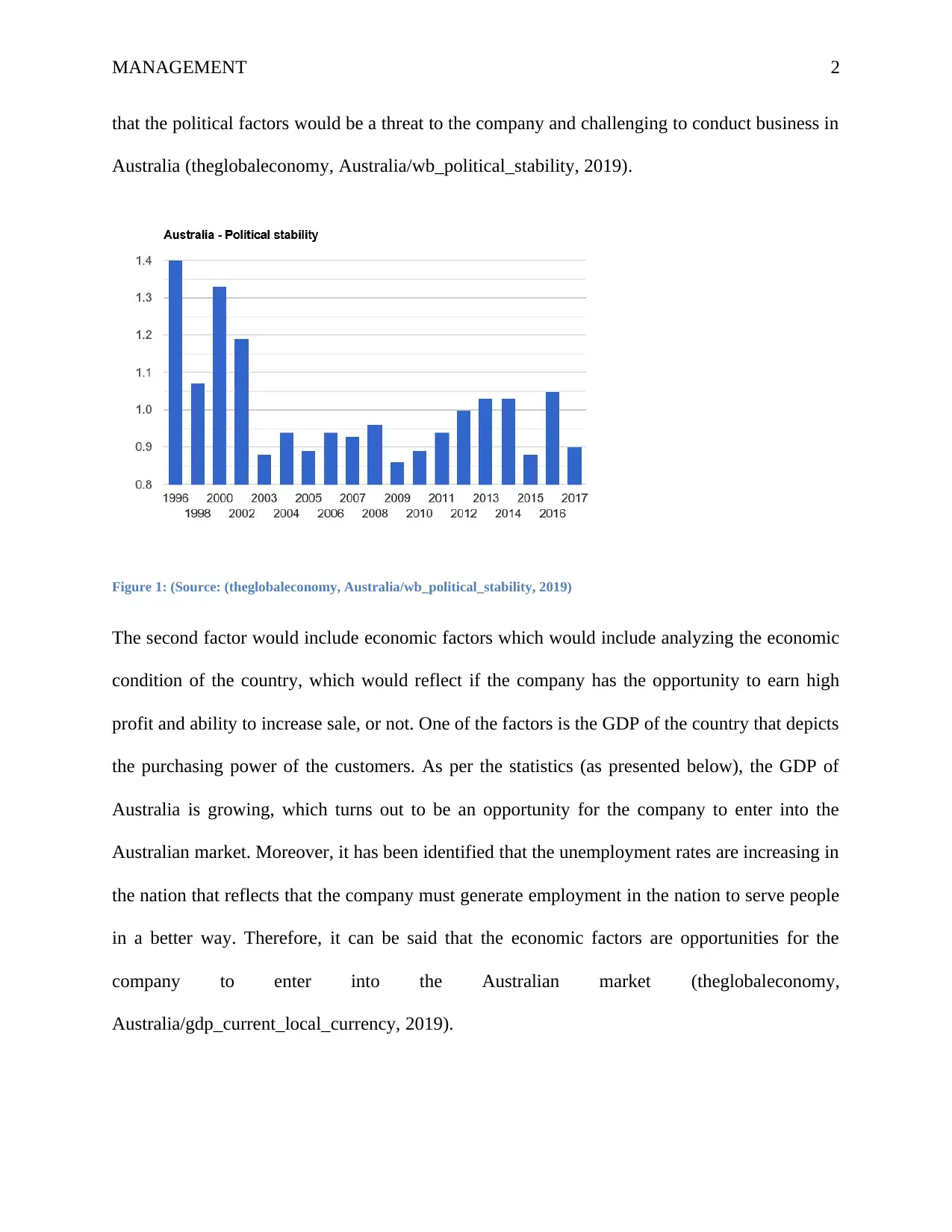
MANAGEMENT 2
that the political factors would be a threat to the company and challenging to conduct business in
Australia (theglobaleconomy, Australia/wb_political_stability, 2019).
Figure 1: (Source: (theglobaleconomy, Australia/wb_political_stability, 2019)
The second factor would include economic factors which would include analyzing the economic
condition of the country, which would reflect if the company has the opportunity to earn high
profit and ability to increase sale, or not. One of the factors is the GDP of the country that depicts
the purchasing power of the customers. As per the statistics (as presented below), the GDP of
Australia is growing, which turns out to be an opportunity for the company to enter into the
Australian market. Moreover, it has been identified that the unemployment rates are increasing in
the nation that reflects that the company must generate employment in the nation to serve people
in a better way. Therefore, it can be said that the economic factors are opportunities for the
company to enter into the Australian market (theglobaleconomy,
Australia/gdp_current_local_currency, 2019).
that the political factors would be a threat to the company and challenging to conduct business in
Australia (theglobaleconomy, Australia/wb_political_stability, 2019).
Figure 1: (Source: (theglobaleconomy, Australia/wb_political_stability, 2019)
The second factor would include economic factors which would include analyzing the economic
condition of the country, which would reflect if the company has the opportunity to earn high
profit and ability to increase sale, or not. One of the factors is the GDP of the country that depicts
the purchasing power of the customers. As per the statistics (as presented below), the GDP of
Australia is growing, which turns out to be an opportunity for the company to enter into the
Australian market. Moreover, it has been identified that the unemployment rates are increasing in
the nation that reflects that the company must generate employment in the nation to serve people
in a better way. Therefore, it can be said that the economic factors are opportunities for the
company to enter into the Australian market (theglobaleconomy,
Australia/gdp_current_local_currency, 2019).
⊘ This is a preview!⊘
Do you want full access?
Subscribe today to unlock all pages.

Trusted by 1+ million students worldwide
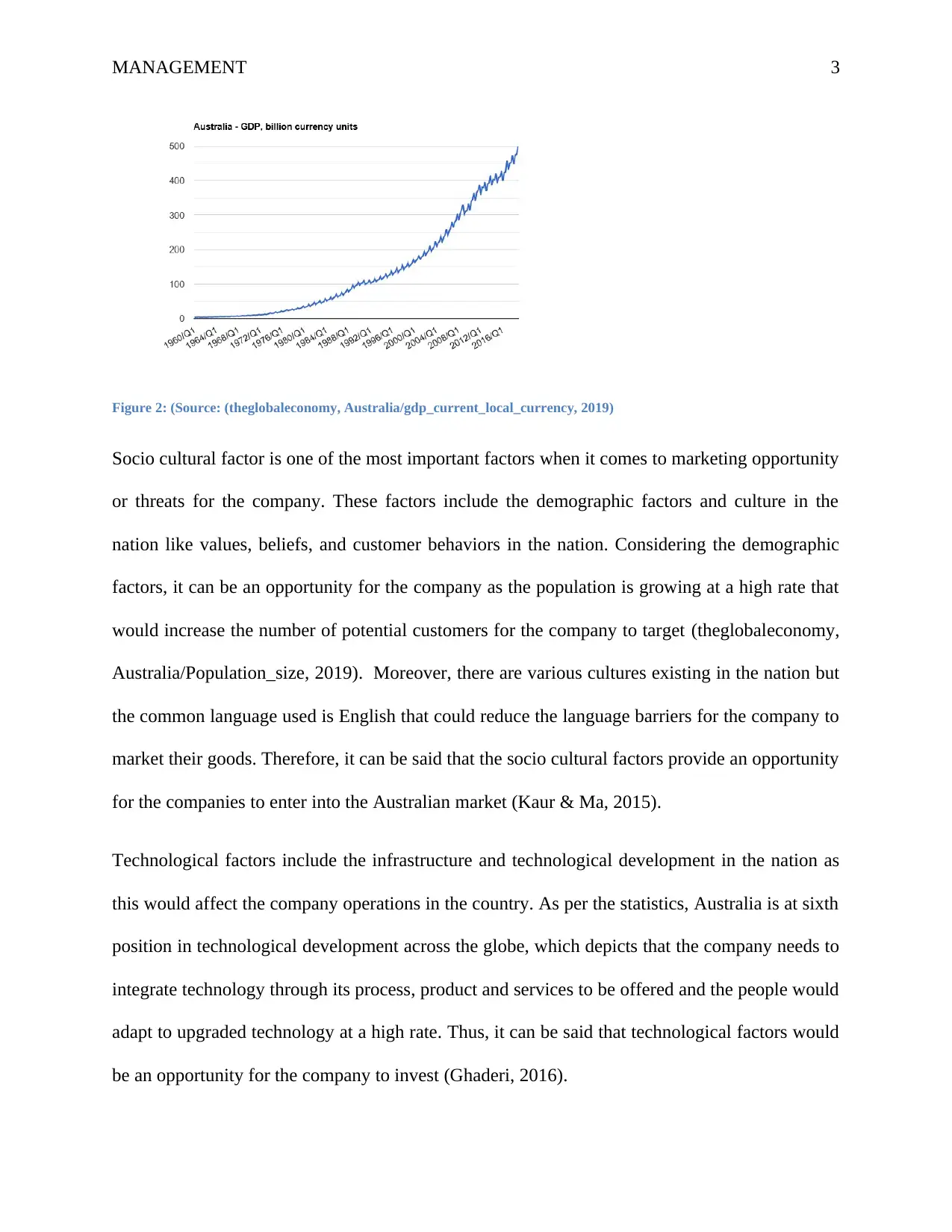
MANAGEMENT 3
Figure 2: (Source: (theglobaleconomy, Australia/gdp_current_local_currency, 2019)
Socio cultural factor is one of the most important factors when it comes to marketing opportunity
or threats for the company. These factors include the demographic factors and culture in the
nation like values, beliefs, and customer behaviors in the nation. Considering the demographic
factors, it can be an opportunity for the company as the population is growing at a high rate that
would increase the number of potential customers for the company to target (theglobaleconomy,
Australia/Population_size, 2019). Moreover, there are various cultures existing in the nation but
the common language used is English that could reduce the language barriers for the company to
market their goods. Therefore, it can be said that the socio cultural factors provide an opportunity
for the companies to enter into the Australian market (Kaur & Ma, 2015).
Technological factors include the infrastructure and technological development in the nation as
this would affect the company operations in the country. As per the statistics, Australia is at sixth
position in technological development across the globe, which depicts that the company needs to
integrate technology through its process, product and services to be offered and the people would
adapt to upgraded technology at a high rate. Thus, it can be said that technological factors would
be an opportunity for the company to invest (Ghaderi, 2016).
Figure 2: (Source: (theglobaleconomy, Australia/gdp_current_local_currency, 2019)
Socio cultural factor is one of the most important factors when it comes to marketing opportunity
or threats for the company. These factors include the demographic factors and culture in the
nation like values, beliefs, and customer behaviors in the nation. Considering the demographic
factors, it can be an opportunity for the company as the population is growing at a high rate that
would increase the number of potential customers for the company to target (theglobaleconomy,
Australia/Population_size, 2019). Moreover, there are various cultures existing in the nation but
the common language used is English that could reduce the language barriers for the company to
market their goods. Therefore, it can be said that the socio cultural factors provide an opportunity
for the companies to enter into the Australian market (Kaur & Ma, 2015).
Technological factors include the infrastructure and technological development in the nation as
this would affect the company operations in the country. As per the statistics, Australia is at sixth
position in technological development across the globe, which depicts that the company needs to
integrate technology through its process, product and services to be offered and the people would
adapt to upgraded technology at a high rate. Thus, it can be said that technological factors would
be an opportunity for the company to invest (Ghaderi, 2016).
Paraphrase This Document
Need a fresh take? Get an instant paraphrase of this document with our AI Paraphraser
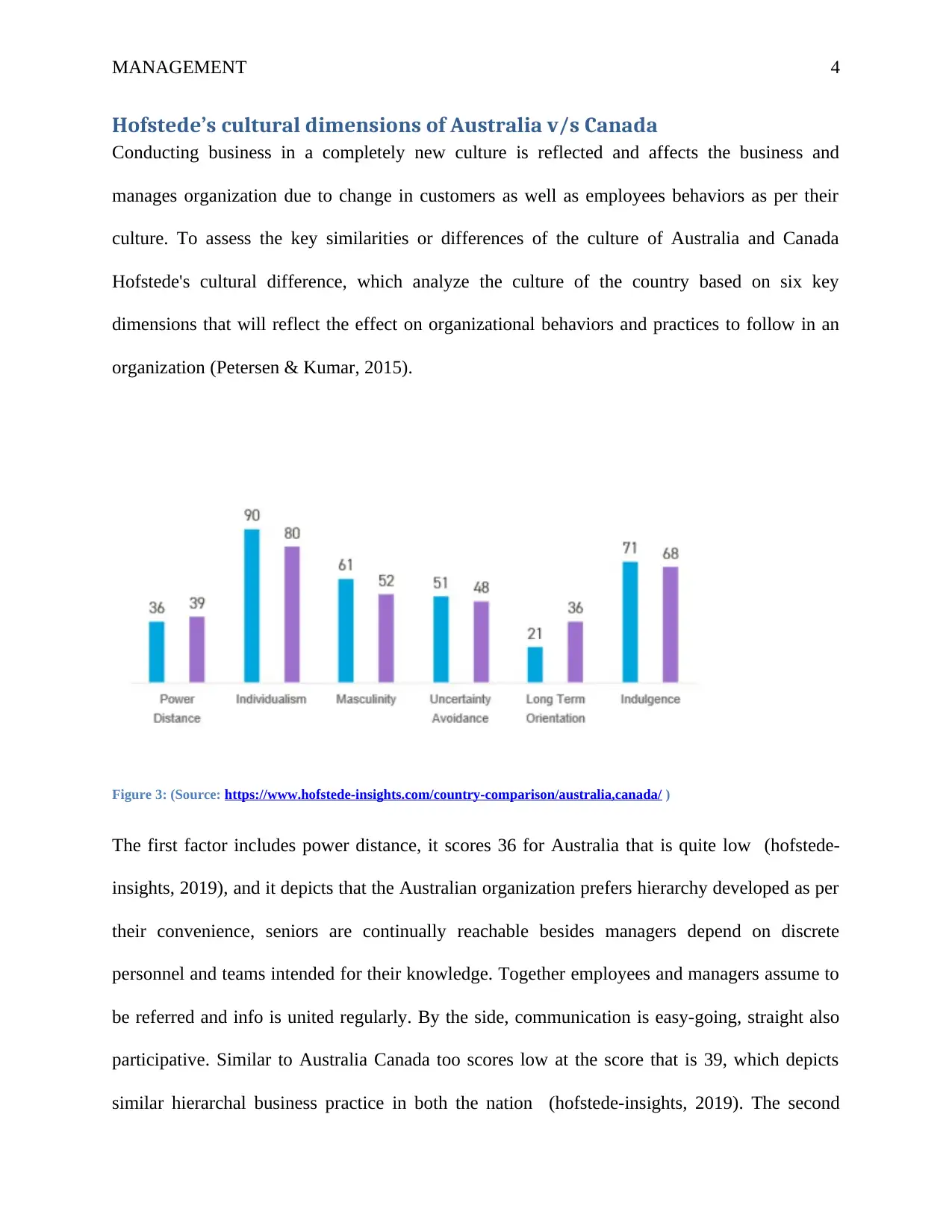
MANAGEMENT 4
Hofstede’s cultural dimensions of Australia v/s Canada
Conducting business in a completely new culture is reflected and affects the business and
manages organization due to change in customers as well as employees behaviors as per their
culture. To assess the key similarities or differences of the culture of Australia and Canada
Hofstede's cultural difference, which analyze the culture of the country based on six key
dimensions that will reflect the effect on organizational behaviors and practices to follow in an
organization (Petersen & Kumar, 2015).
Figure 3: (Source: https://www.hofstede-insights.com/country-comparison/australia,canada/ )
The first factor includes power distance, it scores 36 for Australia that is quite low (hofstede-
insights, 2019), and it depicts that the Australian organization prefers hierarchy developed as per
their convenience, seniors are continually reachable besides managers depend on discrete
personnel and teams intended for their knowledge. Together employees and managers assume to
be referred and info is united regularly. By the side, communication is easy-going, straight also
participative. Similar to Australia Canada too scores low at the score that is 39, which depicts
similar hierarchal business practice in both the nation (hofstede-insights, 2019). The second
Hofstede’s cultural dimensions of Australia v/s Canada
Conducting business in a completely new culture is reflected and affects the business and
manages organization due to change in customers as well as employees behaviors as per their
culture. To assess the key similarities or differences of the culture of Australia and Canada
Hofstede's cultural difference, which analyze the culture of the country based on six key
dimensions that will reflect the effect on organizational behaviors and practices to follow in an
organization (Petersen & Kumar, 2015).
Figure 3: (Source: https://www.hofstede-insights.com/country-comparison/australia,canada/ )
The first factor includes power distance, it scores 36 for Australia that is quite low (hofstede-
insights, 2019), and it depicts that the Australian organization prefers hierarchy developed as per
their convenience, seniors are continually reachable besides managers depend on discrete
personnel and teams intended for their knowledge. Together employees and managers assume to
be referred and info is united regularly. By the side, communication is easy-going, straight also
participative. Similar to Australia Canada too scores low at the score that is 39, which depicts
similar hierarchal business practice in both the nation (hofstede-insights, 2019). The second
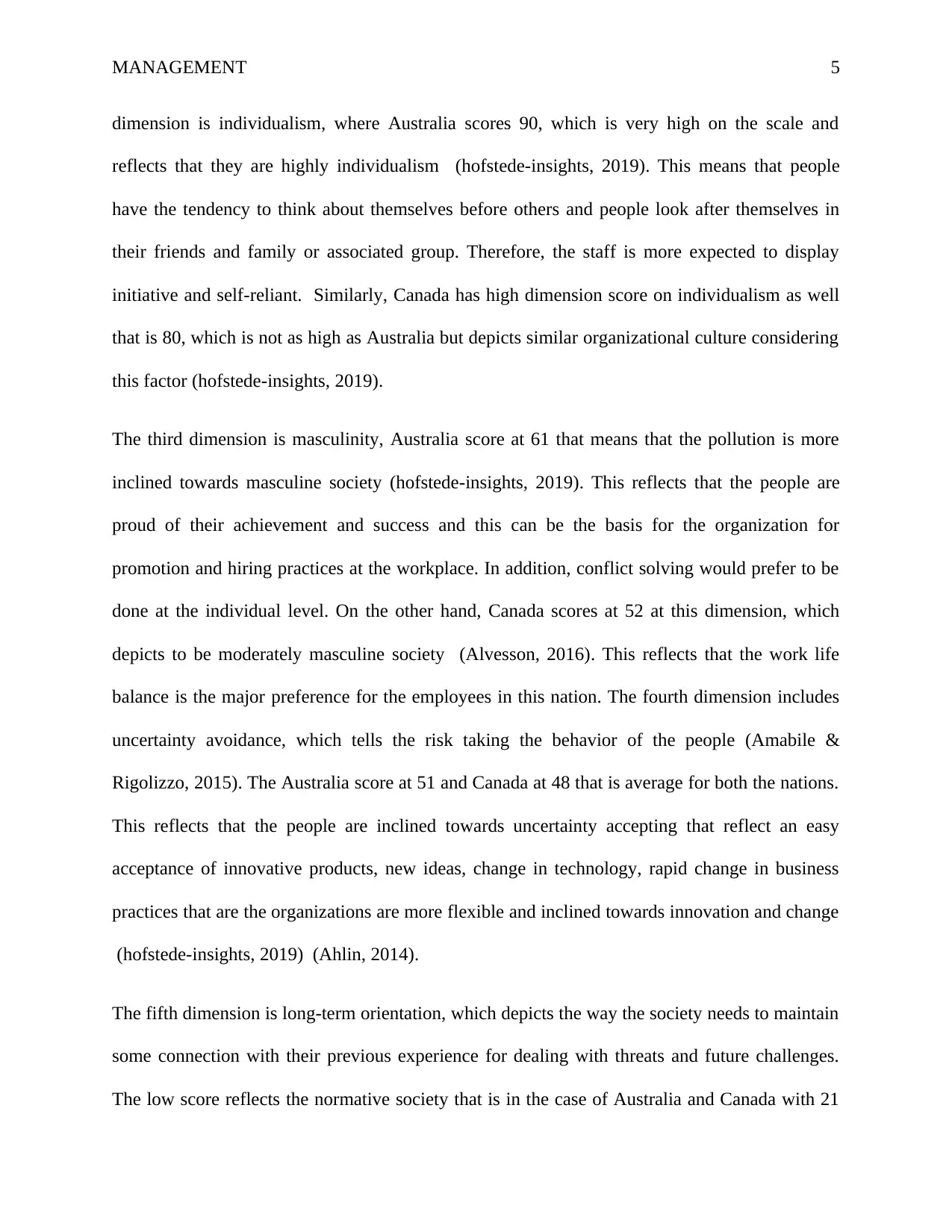
MANAGEMENT 5
dimension is individualism, where Australia scores 90, which is very high on the scale and
reflects that they are highly individualism (hofstede-insights, 2019). This means that people
have the tendency to think about themselves before others and people look after themselves in
their friends and family or associated group. Therefore, the staff is more expected to display
initiative and self-reliant. Similarly, Canada has high dimension score on individualism as well
that is 80, which is not as high as Australia but depicts similar organizational culture considering
this factor (hofstede-insights, 2019).
The third dimension is masculinity, Australia score at 61 that means that the pollution is more
inclined towards masculine society (hofstede-insights, 2019). This reflects that the people are
proud of their achievement and success and this can be the basis for the organization for
promotion and hiring practices at the workplace. In addition, conflict solving would prefer to be
done at the individual level. On the other hand, Canada scores at 52 at this dimension, which
depicts to be moderately masculine society (Alvesson, 2016). This reflects that the work life
balance is the major preference for the employees in this nation. The fourth dimension includes
uncertainty avoidance, which tells the risk taking the behavior of the people (Amabile &
Rigolizzo, 2015). The Australia score at 51 and Canada at 48 that is average for both the nations.
This reflects that the people are inclined towards uncertainty accepting that reflect an easy
acceptance of innovative products, new ideas, change in technology, rapid change in business
practices that are the organizations are more flexible and inclined towards innovation and change
(hofstede-insights, 2019) (Ahlin, 2014).
The fifth dimension is long-term orientation, which depicts the way the society needs to maintain
some connection with their previous experience for dealing with threats and future challenges.
The low score reflects the normative society that is in the case of Australia and Canada with 21
dimension is individualism, where Australia scores 90, which is very high on the scale and
reflects that they are highly individualism (hofstede-insights, 2019). This means that people
have the tendency to think about themselves before others and people look after themselves in
their friends and family or associated group. Therefore, the staff is more expected to display
initiative and self-reliant. Similarly, Canada has high dimension score on individualism as well
that is 80, which is not as high as Australia but depicts similar organizational culture considering
this factor (hofstede-insights, 2019).
The third dimension is masculinity, Australia score at 61 that means that the pollution is more
inclined towards masculine society (hofstede-insights, 2019). This reflects that the people are
proud of their achievement and success and this can be the basis for the organization for
promotion and hiring practices at the workplace. In addition, conflict solving would prefer to be
done at the individual level. On the other hand, Canada scores at 52 at this dimension, which
depicts to be moderately masculine society (Alvesson, 2016). This reflects that the work life
balance is the major preference for the employees in this nation. The fourth dimension includes
uncertainty avoidance, which tells the risk taking the behavior of the people (Amabile &
Rigolizzo, 2015). The Australia score at 51 and Canada at 48 that is average for both the nations.
This reflects that the people are inclined towards uncertainty accepting that reflect an easy
acceptance of innovative products, new ideas, change in technology, rapid change in business
practices that are the organizations are more flexible and inclined towards innovation and change
(hofstede-insights, 2019) (Ahlin, 2014).
The fifth dimension is long-term orientation, which depicts the way the society needs to maintain
some connection with their previous experience for dealing with threats and future challenges.
The low score reflects the normative society that is in the case of Australia and Canada with 21
⊘ This is a preview!⊘
Do you want full access?
Subscribe today to unlock all pages.

Trusted by 1+ million students worldwide
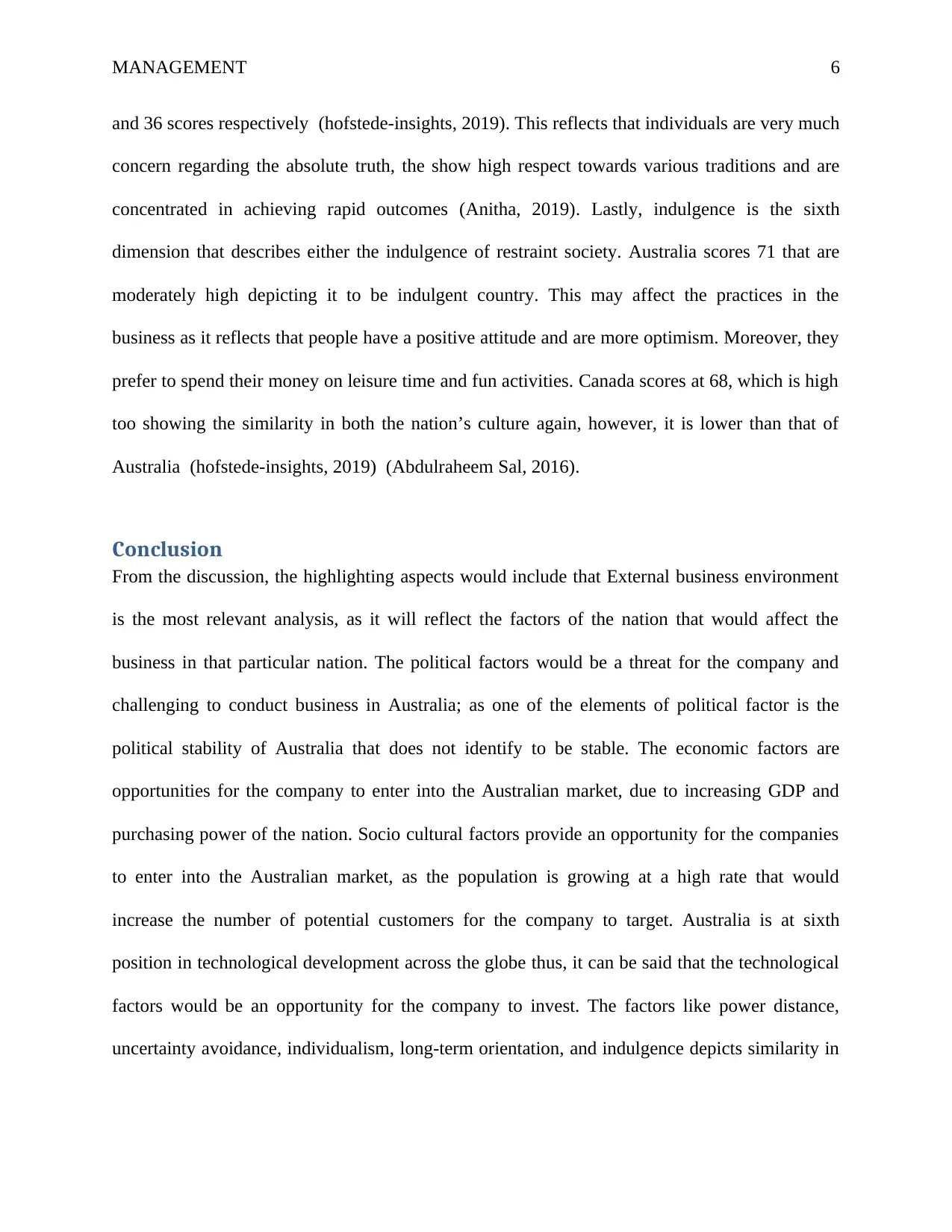
MANAGEMENT 6
and 36 scores respectively (hofstede-insights, 2019). This reflects that individuals are very much
concern regarding the absolute truth, the show high respect towards various traditions and are
concentrated in achieving rapid outcomes (Anitha, 2019). Lastly, indulgence is the sixth
dimension that describes either the indulgence of restraint society. Australia scores 71 that are
moderately high depicting it to be indulgent country. This may affect the practices in the
business as it reflects that people have a positive attitude and are more optimism. Moreover, they
prefer to spend their money on leisure time and fun activities. Canada scores at 68, which is high
too showing the similarity in both the nation’s culture again, however, it is lower than that of
Australia (hofstede-insights, 2019) (Abdulraheem Sal, 2016).
Conclusion
From the discussion, the highlighting aspects would include that External business environment
is the most relevant analysis, as it will reflect the factors of the nation that would affect the
business in that particular nation. The political factors would be a threat for the company and
challenging to conduct business in Australia; as one of the elements of political factor is the
political stability of Australia that does not identify to be stable. The economic factors are
opportunities for the company to enter into the Australian market, due to increasing GDP and
purchasing power of the nation. Socio cultural factors provide an opportunity for the companies
to enter into the Australian market, as the population is growing at a high rate that would
increase the number of potential customers for the company to target. Australia is at sixth
position in technological development across the globe thus, it can be said that the technological
factors would be an opportunity for the company to invest. The factors like power distance,
uncertainty avoidance, individualism, long-term orientation, and indulgence depicts similarity in
and 36 scores respectively (hofstede-insights, 2019). This reflects that individuals are very much
concern regarding the absolute truth, the show high respect towards various traditions and are
concentrated in achieving rapid outcomes (Anitha, 2019). Lastly, indulgence is the sixth
dimension that describes either the indulgence of restraint society. Australia scores 71 that are
moderately high depicting it to be indulgent country. This may affect the practices in the
business as it reflects that people have a positive attitude and are more optimism. Moreover, they
prefer to spend their money on leisure time and fun activities. Canada scores at 68, which is high
too showing the similarity in both the nation’s culture again, however, it is lower than that of
Australia (hofstede-insights, 2019) (Abdulraheem Sal, 2016).
Conclusion
From the discussion, the highlighting aspects would include that External business environment
is the most relevant analysis, as it will reflect the factors of the nation that would affect the
business in that particular nation. The political factors would be a threat for the company and
challenging to conduct business in Australia; as one of the elements of political factor is the
political stability of Australia that does not identify to be stable. The economic factors are
opportunities for the company to enter into the Australian market, due to increasing GDP and
purchasing power of the nation. Socio cultural factors provide an opportunity for the companies
to enter into the Australian market, as the population is growing at a high rate that would
increase the number of potential customers for the company to target. Australia is at sixth
position in technological development across the globe thus, it can be said that the technological
factors would be an opportunity for the company to invest. The factors like power distance,
uncertainty avoidance, individualism, long-term orientation, and indulgence depicts similarity in
Paraphrase This Document
Need a fresh take? Get an instant paraphrase of this document with our AI Paraphraser
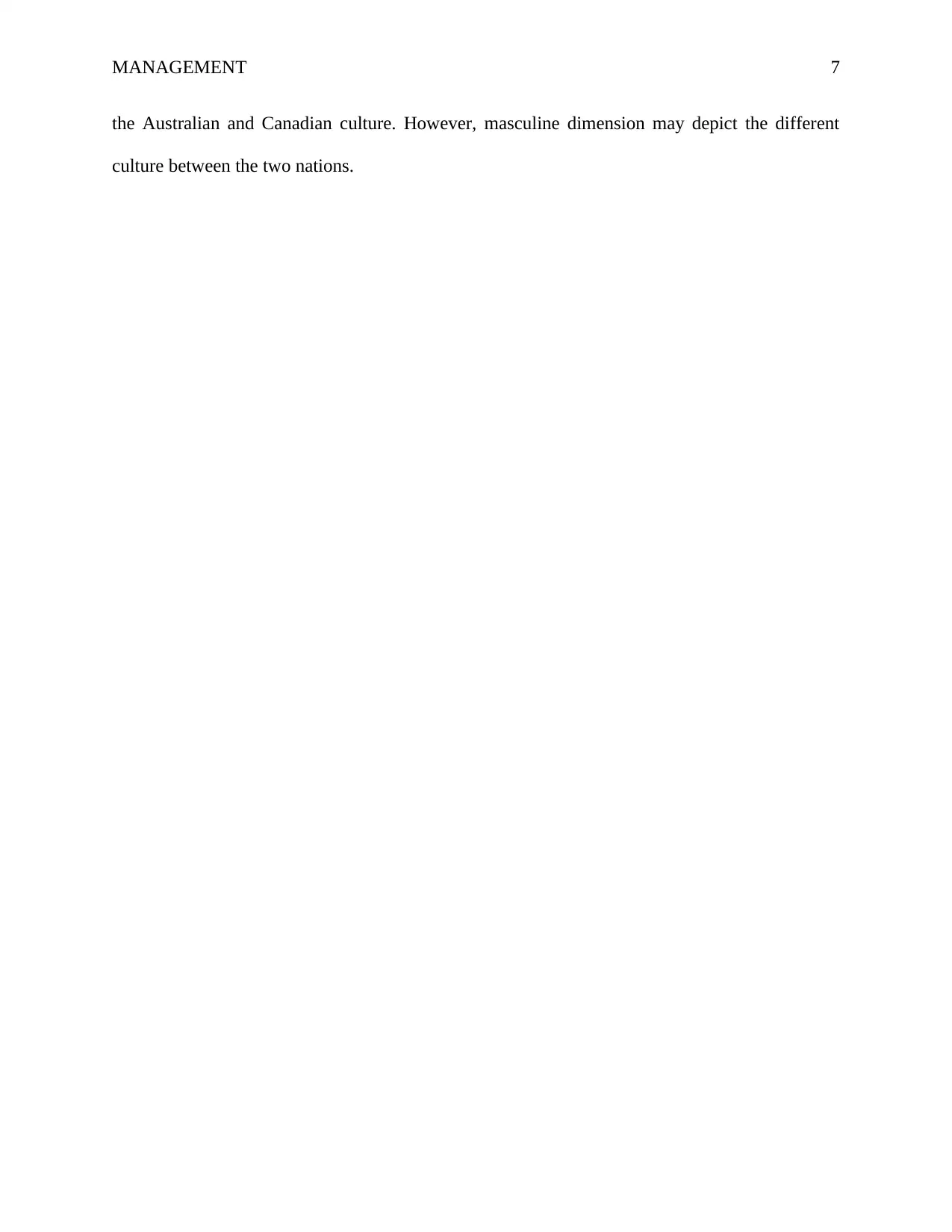
MANAGEMENT 7
the Australian and Canadian culture. However, masculine dimension may depict the different
culture between the two nations.
the Australian and Canadian culture. However, masculine dimension may depict the different
culture between the two nations.
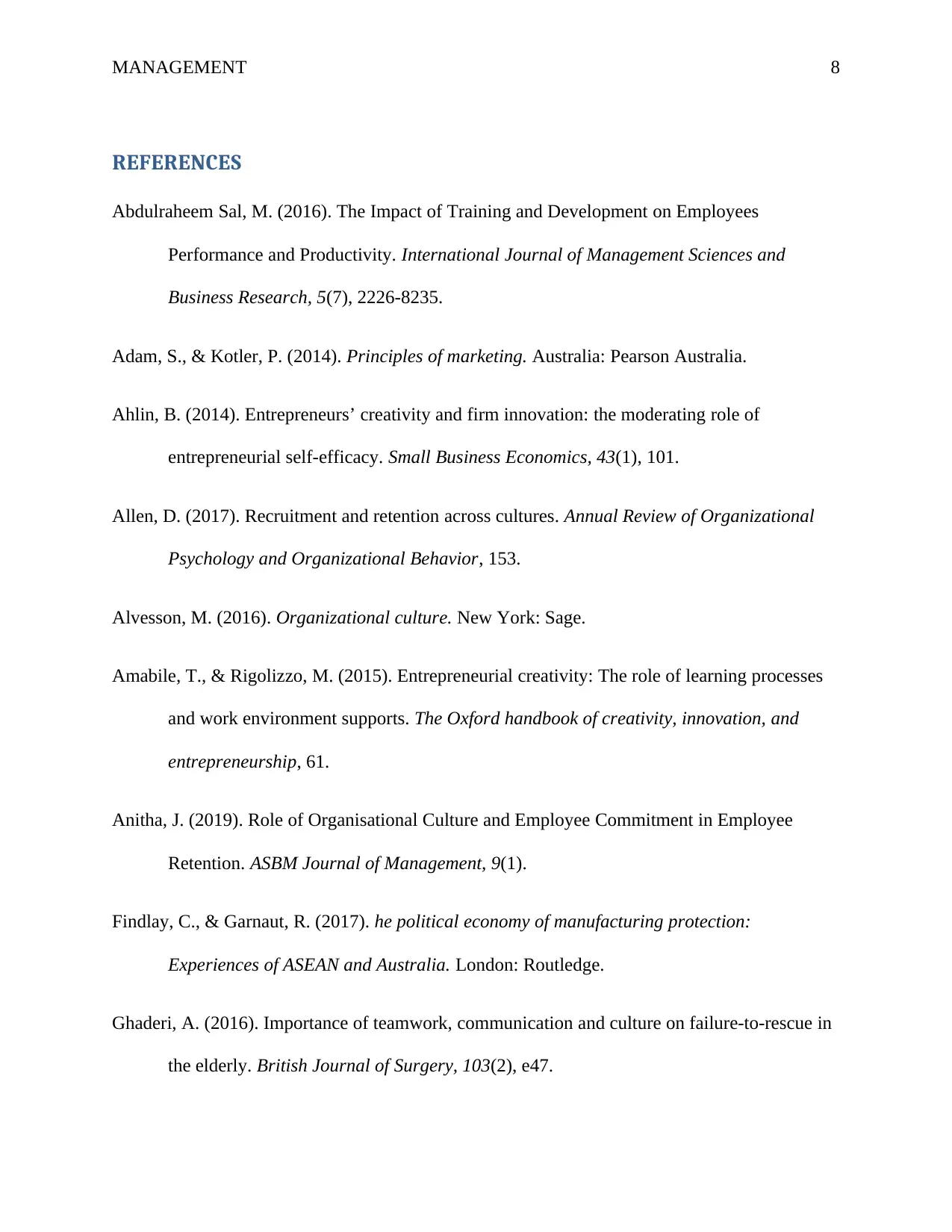
MANAGEMENT 8
REFERENCES
Abdulraheem Sal, M. (2016). The Impact of Training and Development on Employees
Performance and Productivity. International Journal of Management Sciences and
Business Research, 5(7), 2226-8235.
Adam, S., & Kotler, P. (2014). Principles of marketing. Australia: Pearson Australia.
Ahlin, B. (2014). Entrepreneurs’ creativity and firm innovation: the moderating role of
entrepreneurial self-efficacy. Small Business Economics, 43(1), 101.
Allen, D. (2017). Recruitment and retention across cultures. Annual Review of Organizational
Psychology and Organizational Behavior, 153.
Alvesson, M. (2016). Organizational culture. New York: Sage.
Amabile, T., & Rigolizzo, M. (2015). Entrepreneurial creativity: The role of learning processes
and work environment supports. The Oxford handbook of creativity, innovation, and
entrepreneurship, 61.
Anitha, J. (2019). Role of Organisational Culture and Employee Commitment in Employee
Retention. ASBM Journal of Management, 9(1).
Findlay, C., & Garnaut, R. (2017). he political economy of manufacturing protection:
Experiences of ASEAN and Australia. London: Routledge.
Ghaderi, A. (2016). Importance of teamwork, communication and culture on failure‐to‐rescue in
the elderly. British Journal of Surgery, 103(2), e47.
REFERENCES
Abdulraheem Sal, M. (2016). The Impact of Training and Development on Employees
Performance and Productivity. International Journal of Management Sciences and
Business Research, 5(7), 2226-8235.
Adam, S., & Kotler, P. (2014). Principles of marketing. Australia: Pearson Australia.
Ahlin, B. (2014). Entrepreneurs’ creativity and firm innovation: the moderating role of
entrepreneurial self-efficacy. Small Business Economics, 43(1), 101.
Allen, D. (2017). Recruitment and retention across cultures. Annual Review of Organizational
Psychology and Organizational Behavior, 153.
Alvesson, M. (2016). Organizational culture. New York: Sage.
Amabile, T., & Rigolizzo, M. (2015). Entrepreneurial creativity: The role of learning processes
and work environment supports. The Oxford handbook of creativity, innovation, and
entrepreneurship, 61.
Anitha, J. (2019). Role of Organisational Culture and Employee Commitment in Employee
Retention. ASBM Journal of Management, 9(1).
Findlay, C., & Garnaut, R. (2017). he political economy of manufacturing protection:
Experiences of ASEAN and Australia. London: Routledge.
Ghaderi, A. (2016). Importance of teamwork, communication and culture on failure‐to‐rescue in
the elderly. British Journal of Surgery, 103(2), e47.
⊘ This is a preview!⊘
Do you want full access?
Subscribe today to unlock all pages.

Trusted by 1+ million students worldwide
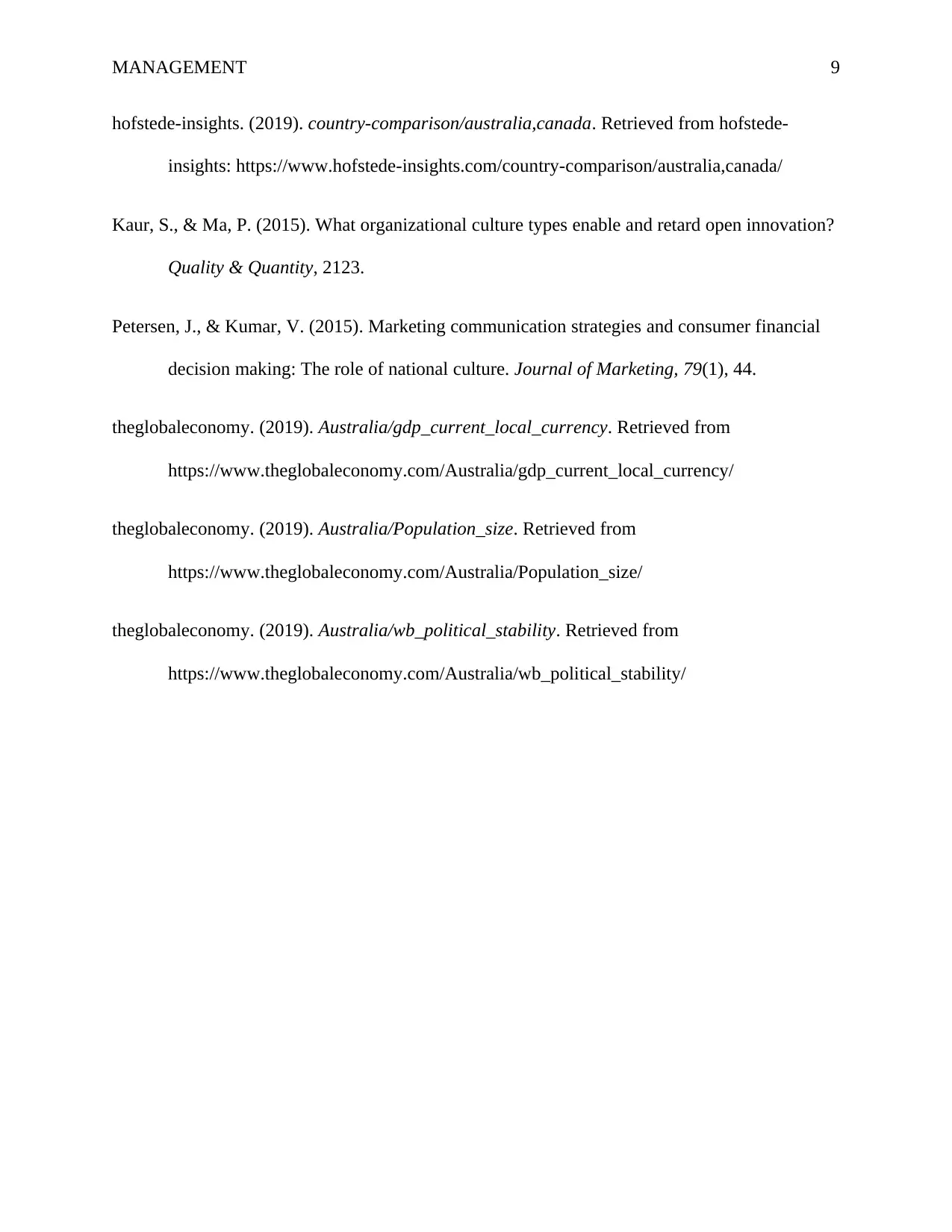
MANAGEMENT 9
hofstede-insights. (2019). country-comparison/australia,canada. Retrieved from hofstede-
insights: https://www.hofstede-insights.com/country-comparison/australia,canada/
Kaur, S., & Ma, P. (2015). What organizational culture types enable and retard open innovation?
Quality & Quantity, 2123.
Petersen, J., & Kumar, V. (2015). Marketing communication strategies and consumer financial
decision making: The role of national culture. Journal of Marketing, 79(1), 44.
theglobaleconomy. (2019). Australia/gdp_current_local_currency. Retrieved from
https://www.theglobaleconomy.com/Australia/gdp_current_local_currency/
theglobaleconomy. (2019). Australia/Population_size. Retrieved from
https://www.theglobaleconomy.com/Australia/Population_size/
theglobaleconomy. (2019). Australia/wb_political_stability. Retrieved from
https://www.theglobaleconomy.com/Australia/wb_political_stability/
hofstede-insights. (2019). country-comparison/australia,canada. Retrieved from hofstede-
insights: https://www.hofstede-insights.com/country-comparison/australia,canada/
Kaur, S., & Ma, P. (2015). What organizational culture types enable and retard open innovation?
Quality & Quantity, 2123.
Petersen, J., & Kumar, V. (2015). Marketing communication strategies and consumer financial
decision making: The role of national culture. Journal of Marketing, 79(1), 44.
theglobaleconomy. (2019). Australia/gdp_current_local_currency. Retrieved from
https://www.theglobaleconomy.com/Australia/gdp_current_local_currency/
theglobaleconomy. (2019). Australia/Population_size. Retrieved from
https://www.theglobaleconomy.com/Australia/Population_size/
theglobaleconomy. (2019). Australia/wb_political_stability. Retrieved from
https://www.theglobaleconomy.com/Australia/wb_political_stability/
1 out of 10
Related Documents
Your All-in-One AI-Powered Toolkit for Academic Success.
+13062052269
info@desklib.com
Available 24*7 on WhatsApp / Email
![[object Object]](/_next/static/media/star-bottom.7253800d.svg)
Unlock your academic potential
Copyright © 2020–2025 A2Z Services. All Rights Reserved. Developed and managed by ZUCOL.





